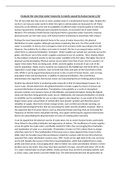Evaluate the view that water insecurity is mainly caused by human factors [20]
The UN has ruled that free access to clean, potable water is a fundamental human right. Despite this,
we live in an insecure water world in which this right is unfortunately not honoured for all. Water
insecurity can be defined as the lack of availability of sufficient water of good quality to meet basic
human requirements, livelihoods and ecosystem functions, an increased risk of water-linked
disasters. The interplay of both human and physical factors generates water insecurity, however
physical factors are the main cause, with human factors functioning to exacerbate their impact.
Perhaps the most important physical factor in the cause of water insecurity is the physical
distribution of water supplies. Although surprising considering that only 1% of the world’s fresh
water is accessible, in theory, this is enough to meet all of our basic needs (according to the UN).
However, the problem lies in where such water is located. We live in an unequal water world in
which there is a physical distribution ‘mismatch’. Water supplies are spread very unevenly across the
globe, with 60 per cent of the world’s supplies contained in just 10 countries. This is directly linked
to the problem of physical scarcity as the less water available in the first place, the higher the risk of
physical scarcity developing. Physical scarcity occurs when more than 75 per cent of a country’s or
region’s blue water flows are being used, which currently applies to around 25 per cent of the
world’s population. Water-scarce countries are clustered in the Middle East and North Africa, and
regionally in some larger countries, such as North East China and parts of the Great Plains of the
USA. Whilst it can be argued that physical scarcity is also a result of human factors, such as rising
population levels and development, in addition to physical distribution, this nevertheless
demonstrates the argument that human factors are exacerbating the pre-existing physical factors.
Another key physical factor in producing water insecurity is that of meteorological causes. At a
macro-scale, climate determines the global distraction of water supply by means of annual and
seasonal distribution of precipitation. Precipitation varies globally as a result of atmospheric
pressure systems. Low pressure zones of mid-latitudes, and equatorial regions having the highest
totals and therefore being generally water secure. Additionally, the seasonal distribution of rainfall,
its reliability and its availability for use as water supply is also important. A case study of the Sahel
Region shows lower annual totals of rainfall often have greater variation and therefore poorer
reliability of supply. Short-term climate change events, such as ENSO and climate warming, are
physical/meteorological factors that are worsening the water security situation. However, there is
the argument that it is human factors, such as enhanced climate warming, that are increasing the
frequency of climate events and global warming, once again reinforcing the argument that human
factors are exacerbating the physical factors in terms of creating water insecurity.
It can be argued that the physical scarcity of water gives rise to certain human factors, particularly
those linked to the political attitudes and approaches of nations. The insufficiency of water supplies
across the globe has made water a profitable market for TNCs, thus encouraging the privatisation
and exploitation of water as a commodity. Privatisation of water via TNCs allows them to charge
what they want for it. The manifestation of this issue was no more apparent than it was in Paris,
2008, when the Socialist mayor Bernard Delanoe ended the contacts with the two firms that had
operated Paris water distribution systems since 1985- Veolia on the right bank of the city, and Suez
on the left. Despite the success of the Paris remunicipalisation, which had enabled Paris to make
profits and lower prices, encouraging other cities to follow suit, water privatisation remains a severe
problem across the world. Since they have been stymied in Europe, and with only about 10% of the
U.S. water marked open to private utilities, Veolia and Suez have turned to emerging markets such
as China, India, Latin America and the Middle East. This shift demonstrates that the generation of





